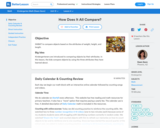
Students further their understanding of finding the greatest common factor and least common multiples.
- Subject:
- Mathematics
- Material Type:
- Lesson Plan
- Provider:
- BetterLesson
- Date Added:
- 12/01/2022

Students further their understanding of finding the greatest common factor and least common multiples.

Students show what they know about greatest common factor and east common multiple.

When would you come across GCF and LCM? Students apply their knowledge of GCF and LCM to solve word problems.

Students differentiate between greatest common factor and least common multiple word problems.

Students will be able to make use of structure on their way to deriving a formula for the sum of a geometric series. They will also gain more experience in finding the nth term of a sequence/series. Includes short video. [1:15]

Students start to familiarize themselves with applying and attending college. This will serve as a frame for the work they will do throughout the unit.

Students graph the weather in Vermont for the month of January.

Students can collect and represent data with a unique scale.

Clearly understand the difference between factors and multiples builds a foundation for applications and problem solving using GCF and LCM.

Kindergarteners are introduced to comparing objects by their attributes. In this lesson, the kids compare objects by using the three attributes they have learned about.

Before entering first grade, young children need to have a basic understanding of measurement. They do not need to be able to use standard units of measurement, but they must be able to use the basic attributes of length.

In this lesson, students will investigate and discuss the familiarity with factors and multiples to gain a deeper understanding. Downloadable printables are included.

Students worked on telling time to the hour and half hour earlier in the year. Now they will apply their understanding of counting by 5s to telling time to the five minute interval.

Before entering first grade, young children need to have a basic understanding of measurement. They do not need to be able to use standard units of measurement, but they must be able to use the basic attributes to make comparisons in length.

Learning about factors and multiples allows students to see number relationships and apply those number relationships to multiplication and division.

Using the size of the planets, students are able to work with numbers to 1,000. This lesson introduces larger numbers (even beyond 1,000) to extend student understanding of the patterns in numbers.

This lesson will teach 2 methods of finding the least common multiple. Students will then complete activities using both methods to figure out which method they prefer.

Students discover how electricity can be converted to light energy.

Kindergarteners need a variety of experiences to ensure they build a strong foundation on a topic. This lesson gives them another opportunity to compare height, this time using themselves as the objects.

La, La, La, La, La, sing a happy song! You will be signing like a Smurf as students use their new founded knowledge of shape characteristics to participate in a whole group discussion and to successfully participate in geometric learning.